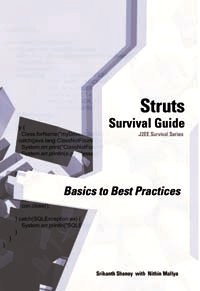
|
FreeComputerBooks.com
Links to Free Computer, Mathematics, Technical Books all over the World
|
|
- Title: Struts Survival Guide: Basics to Best Practices
- Author(s) Srikanth Shenoy, Nithin Mallya
- Publisher: ObjectSource Publications (February 2004)
- Paperback: 224 pages
- eBook: PDF (227 pages, 4.2 MB)
- Language: English
- ISBN-10: 0974848808
- ISBN-13: 978-0974848808
- Share This:

|
Struts is the most popular MVC framework used for J2EE web application development. This book covers the Struts architecture and basics such as data validation, tags and I18N. In addition, it covers a lot of tips, strategies and best practices for Struts based application design and development, many of them not found elsewhere. It tells you how to fill the gaps in Struts and what features are important in J2EE projects.
The book provides a robust exception handling strategy that is production-ready. You will learn how to edit List based forms in Struts. You will also see how to use Paging framework with Struts and neat tricks. You will see when does customizing Struts really make sense in real projects.
What's inside
- Struts basics - architecture, validation, tags, I18N
- Best Practices for designing Action classes
- Action chaining
- Robust exception handling with Struts
- Using Image buttons in Forms
- List Forms
- Paging libraries for Struts
- Handling Duplicate Form submission in generic way
- Customizing Struts
-
Srikanth Shenoy specializes in the architecture, design, development, and deployment of large J2EE and EAI projects. He has helped clients in the manufacturing, logistics, and financial sectors to realize the Java's "write once, run anywhere" dream.
-
Nithin Mallya specializes in providing enterprise solutions for financial clients. He has built transaction intensive systems using various distributed object technologies.
- Java Web Frameworks, MVC - Srtuts, JSF, Spring MVC, etc
- Java Web Programming (Servlet and JSP)
- Java Enterprise Applications
- Web Frameworks
- Web Design and Programming

- Struts Survival Guide: Basics to Best Practices (Srikanth Shenoy)
- The Mirror Site (1) - PDF
- The Mirror Site (2) - PDF
- The Mirror Site (3) - PDF
-
 Starting Struts 2 (Ian Roughley)
Starting Struts 2 (Ian Roughley)
Within this book you will find everything you need to get up and running using Struts2 - from the architecture and configuration, to implementing actions and the supporting infrastructure such as validation and internationalization.
-
 Struts Kick Start (James Turner, et al.)
Struts Kick Start (James Turner, et al.)
This book provides the systematic exploration required by newcomers as well as the step-by-step instruction for more experienced readers eager to exploit Struts to the fullest. An essential resource for all programmers of the next stage in the web.
-
 Jakarta Struts Live (Rick Hightower)
Jakarta Struts Live (Rick Hightower)
This book contains thorough coverage of both the Struts MVC architecture and building each of the Struts components of this architecture. You'll learn to use vital features like Tiles, the Validator, DynaActionForms, plug-ins, and internationalization.
-
 Building Back-End Web Apps with Java, JPA and JSF (G. Wagner)
Building Back-End Web Apps with Java, JPA and JSF (G. Wagner)
This book shows how to build back-end web applications with Java, JPA and JSF as back-end components, including data validation and UI page creation, while the front-end only consists of a web browser's rendering of HTML-forms-based UI pages.
-
 The Angular Mini-Book - Introduction to Angular and Spring Boot
The Angular Mini-Book - Introduction to Angular and Spring Boot
This book is aimed specifically at web or Java developers who want a rapid introduction to Angular, Bootstrap, and Spring Boot. It is also a guide to getting started with Angular. You'll learn how to develop a bare-bones application, test it, and deploy it.
-
 Building Modern Web Apps with Spring Boot and Vaadin
Building Modern Web Apps with Spring Boot and Vaadin
This guide is a practical introduction to web application development with Spring Boot and Vaadin. It covers the entire development process, from setup to deployment, following a step-by-step approach.
-
 The JHipster Mini-Book (Matt Raible)
The JHipster Mini-Book (Matt Raible)
This book shows you how to build an app with JHipster, and guides you through the plethora of tools, techniques and options you can use. Furthermore, it explains the UI and API building blocks so you understand the underpinnings of your great application.





